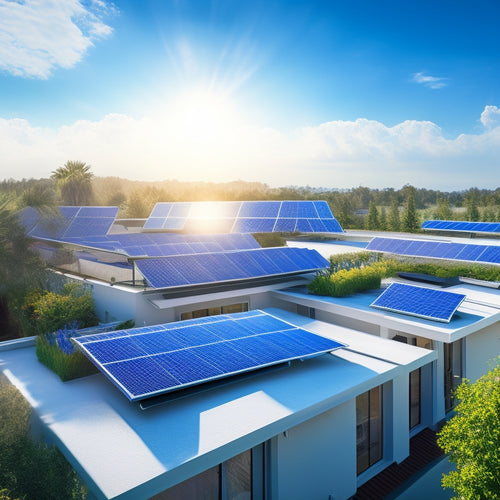
What Makes a Residential System Truly Efficient?
Share
When designing a residential solar system, you need to take into account multiple factors to achieve true efficiency. A well-optimized system size and layout, combined with high-efficiency solar panels, can greatly enhance energy output. Effective inverter and monitoring systems also play a vital role in minimizing energy losses. Smart battery integration strategies and careful consideration of roof and structural factors are equally important. By combining these elements, you can create a system that maximizes energy production and reduces waste. As you explore these factors in more depth, you'll uncover the nuances that set truly efficient systems apart.
Key Takeaways
• A thorough shading analysis and strategic panel positioning minimize energy losses and ensure peak energy harvesting in residential systems.
• Selecting high-efficiency solar panels with ratings above 20% efficiency significantly enhances energy output and increases ROI.
• Proper inverter sizing and effective system monitoring are crucial for maximizing energy production, detecting anomalies, and optimizing system performance.
• Smart battery integration strategies, such as load shifting and time-of-use optimization, reduce energy costs and increase overall system efficiency.
• Careful consideration of roof orientation, structural integrity, and weather conditions ensures a safe and efficient rooftop solar array installation.
Optimizing System Size and Layout
When designing a residential system, you must consider optimizing system size and layout to minimize energy losses and maximize efficiency, as undersized or oversized systems can lead to reduced performance and increased energy consumption.
A thorough shading analysis is vital to identify potential obstacles that could reduce energy output. This involves evaluating the impact of surrounding structures, trees, and other environmental factors on your system's performance. By doing so, you can strategically position your solar panels to minimize energy losses and guarantee peak energy harvesting.
Proper cable management is also essential for efficient system operation. Well-organized cables reduce electrical losses, minimize heat buildup, and make maintenance easier. A well-designed system layout can decrease energy losses by up to 5%, making it a critical aspect of system optimization.
Selecting High-Efficiency Solar Panels
By opting for high-efficiency solar panels, you can greatly enhance your residential system's energy output. These cutting-edge modules are designed to convert a higher percentage of sunlight into usable electricity. With high-efficiency panels, you can maximize your energy yield, even in limited roof space.
Look for panels with high-efficiency ratings, typically above 20%. These panels often feature advanced technologies like bifacial cells, which can increase energy output by up to 25%.
When selecting high-efficiency panels, consider panel durability as a key factor. High-quality panels with durable materials and robust construction can withstand harsh weather conditions, ensuring a longer lifespan and reduced maintenance costs. A durable panel can maintain its energy yield over time, ensuring a higher return on investment.
Effective Inverter and Monitoring
When designing a residential solar system, you'll want to make sure that your inverter is properly sized to handle the output of your solar panels. A well-matched inverter will maximize energy production and reduce energy losses.
Inverter Sizing Matters
Your solar panel system's performance heavily relies on proper inverter sizing, as undersizing or oversizing can have a significant impact on your energy harvest and overall system efficiency. When it comes to inverter sizing, precision is essential.
Conducting accurate load calculations is vital to determine the ideal inverter size for your system. This involves evaluating your energy usage patterns, taking into consideration factors like appliance wattage and usage frequency.
Undersizing your inverter can lead to energy losses, as it may not be able to handle peak energy demands. On the other hand, oversizing can result in wasted resources and increased costs. Proper inverter sizing ensures that your system operates at efficient levels, minimizing energy losses and maximizing energy harvest.
Optimal System Monitoring
Accurate system monitoring enables you to track your solar panel system's performance in real-time, providing critical insights to optimize energy production and identify potential issues before they impact your energy independence.
With real-time tracking, you can:
-
Detect anomalies: Identify unusual patterns in energy production, indicating potential issues that need attention.
-
Optimize energy production: Adjust your system's performance to maximize energy output, ensuring you're getting the most out of your solar panels.
-
Receive automated alerts: Get notified immediately if any issues arise, allowing you to take prompt action and minimize downtime.
Smart Battery Integration Strategies
By harnessing advanced smart battery integration strategies, homeowners can maximize their residential energy systems, enhancing efficiency and minimizing reliance on the grid. You can realize the full potential of your system by implementing smart battery integration strategies that prioritize energy storage and distribution.
To achieve peak energy efficiency, consider the following strategies:
| Strategy | Benefits |
|---|---|
| Load Shifting | Shifts energy usage from peak hours to off-peak hours, reducing strain on the grid |
| Peak Shaving | Reduces energy consumption during peak hours, minimizing strain on the grid |
| Time-of-Use Optimization | Optimizes energy usage based on time-of-use pricing, reducing energy costs |
| Renewable Energy Integration | Integrates renewable energy sources, such as solar or wind, to reduce reliance on the grid |
| Energy Storage Optimization | Optimizes energy storage and distribution, ensuring maximum efficiency |
Roof and Structural Considerations
When designing a residential energy system, it's important to evaluate the roof's structural integrity and loading capacity to guarantee a safe and efficient installation. You want to make sure that your roof can support the weight of the solar panels, batteries, and other equipment.
This is especially vital if you're planning to integrate a rooftop solar array, as the panels will be exposed to various weather conditions.
To guarantee a secure and efficient installation, consider the following key factors:
-
Roof orientation: The direction your roof faces can greatly impact the performance of your solar panels. A south-facing roof is ideal, but east- and west-facing roofs can also work well.
-
Structural integrity: Assess the roof's condition, age, and material to determine if it can support the added weight of the energy system.
-
Loading capacity: Calculate the maximum weight the roof can handle, taking into account the weight of the equipment, snow loads, and wind resistance.
Data-Driven Performance Analysis
You'll need to collect and analyze performance data to optimize your residential energy system, ensuring it operates efficiently and effectively. This involves tracking energy usage and monitoring system performance to identify areas for improvement. By leveraging data-driven insights, you can fine-tune your system to maximize energy efficiency and reduce waste.
To achieve this, you'll need to implement a robust energy tracking system. This will enable you to monitor energy usage in real-time, identifying opportunities to optimize system performance. Performance benchmarking is also essential, allowing you to compare your system's performance to industry standards and best practices.
Here's a breakdown of key performance indicators (KPIs) to track:
| KPI | Description |
|---|---|
| Energy Consumption | Total energy usage in kWh |
| System Efficiency | Ratio of energy output to input |
| Energy Cost | Total energy cost in dollars |
| Carbon Footprint | Total greenhouse gas emissions in kg CO2e |
Frequently Asked Questions
Can I Install a Residential Solar System Myself to Save Money?
"Measure twice, cut once" - wise words to heed when considering DIY solar installation. You'll risk voiding warranties, electrical shocks, and inaccurately sized systems, potentially offsetting any cost savings; a professional installation may be worth the extra upfront cost.
Are Energy Storage Systems Compatible With All Solar Panels?
When selecting an energy storage system, you'll need to guarantee compatibility with your solar panels, taking into account factors like battery capacity and panel integration to optimize performance, as not all systems are created equal.
How Often Should I Clean My Solar Panels to Maintain Efficiency?
"Ha! You think dust bunnies under your couch are bad? Dust on your solar panels is way worse! Clean them every 6-12 months to maintain efficiency, as dirty panels can decrease energy output by up to 25% - ouch!"
Will a Residential Solar System Increase My Property's Value?
You'll likely see a boost in your property's value, as a residential solar system can increase your property appraisal by up to 4.1%, according to a National Renewable Energy Laboratory study, yielding significant real estate benefits.
Can I Use My Residential Solar System During a Power Outage?
"Like a beacon of light in the dark, your residential solar system can be a lifesaver during a power outage, but only if you have a grid-tie system with backup power capabilities, allowing you to harness the energy independence you crave."
Related Posts
-

3 Best State and Local Solar Incentives USA
You can greatly reduce your energy dependence and save thousands of dollars by taking advantage of the top state and ...
-

Step-by-Step Guide to Converting Your Vehicle to EV
You'll begin by evaluating your vehicle's conversion potential, analyzing its weight, aerodynamics, and powertrain co...
-

Best Solar Panel Options for Maximum Energy Savings
You can maximize your energy savings with solar panels that boast efficiency ratings above 20%, paired with extensive...


